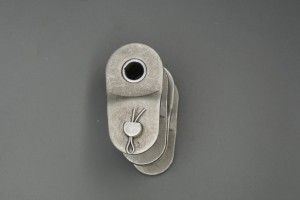When it comes to the smooth operation of industrial machinery, few components are as critical as roller chains. These simple yet complex devices are the backbone of countless applications ranging from conveyor systems to motorcycles. But have you ever wondered what it takes to make a roller chain? In this blog post, we’ll take a deep dive into what makes up a roller chain, exploring the materials and manufacturing processes that contribute to its reliability and strength.
1. Steel: the foundation of strength
At the heart of every roller chain is steel, a versatile and strong material that ensures peak performance in demanding conditions. The pins, bushings and plates that make up roller chains are usually made of high-quality alloys or carbon steel. These alloys have an excellent strength-to-weight ratio, providing the necessary durability and wear resistance.
2. Heat treatment: Enhanced durability
To further improve the performance and life of the roller chain, heat treatment is used. The process involves heating a steel part to a specific temperature followed by rapid quenching or cooling. Heat treatment helps impart desired mechanical properties to steel, such as increased hardness, toughness and wear resistance. Thanks to this important step, roller chains can reliably transmit power while withstanding heavy loads and frequent operating cycles.
3. Lubrication: reduces friction and wear
Roller chains function by precisely interlocking their individual components, relying on lubrication to reduce friction and premature wear. Various methods of lubrication exist, from traditional oil-based lubricants to modern synthetic lubricants. Proper lubrication not only minimizes energy loss through friction, it also reduces the chance of corrosion, elongation and premature failure. Regular lubrication maintenance is essential to ensure optimal performance and long life of your roller chain.
4. Protective coating: shielding from environmental factors
In harsh or corrosive environments, roller chains benefit from a protective coating to protect them from the elements. Protective coatings can include materials such as nickel, zinc, or even specialized polymer coatings. These coatings act as an additional barrier against rust, corrosion and contamination. By proactively addressing the effects of the surrounding environment, roller chains maintain their functionality and integrity, reducing downtime and maintenance costs.
5. Quality manufacturing: fine workmanship
The composition of a roller chain alone is not enough to guarantee its reliability and efficiency. Meticulous manufacturing processes play an important role in producing first-class roller chains. From the initial design phase to final assembly, each component needs to be manufactured with extreme precision. Any inaccuracies or flaws in the manufacturing process can affect the performance and safety of the roller chain. Reliable manufacturers adhere to strict quality control measures to ensure that only the highest standards are followed.
Roller chains may appear simple, but their composition reveals a complex fusion of materials, workmanship and craftsmanship. Steel forms the base, heat treatment strengthens the base, and lubricating and protective coatings optimize performance and life. When these elements are brought together through precision manufacturing, roller chains become resilient workhorses that contribute to the seamless operation of industrial machinery in various fields. So the next time you’re looking at a smooth-running conveyor or a powerful motorcycle, remember the silent contribution that roller chains make in making it all possible.
Post time: Aug-18-2023

